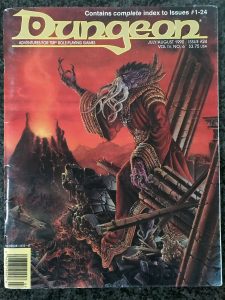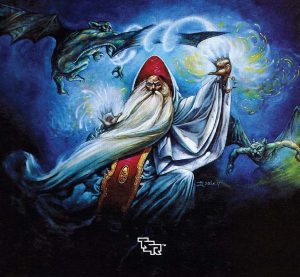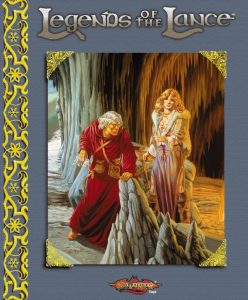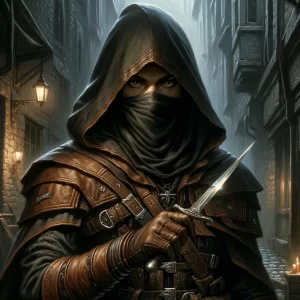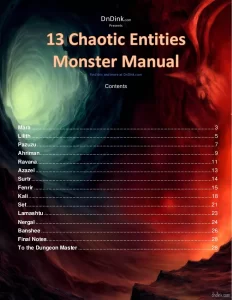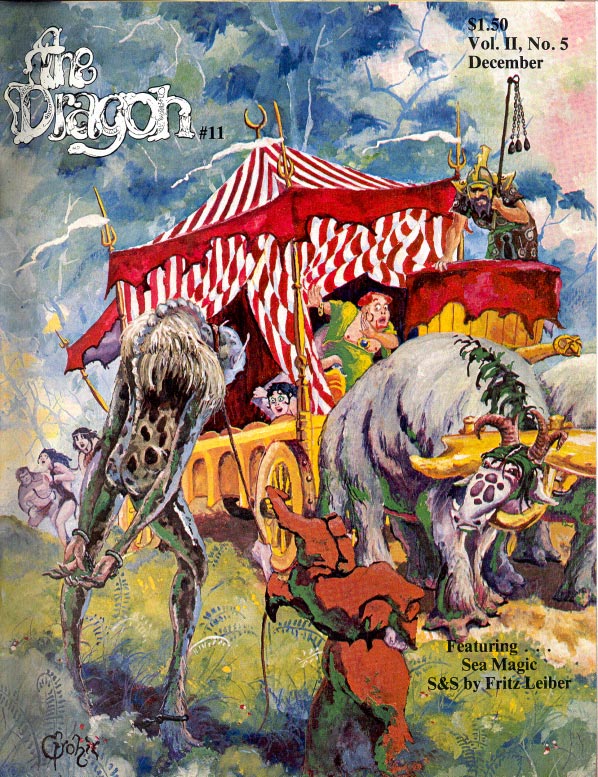
The eleventh issue of Dragon Magazine published in December 1977 is a remarkable document that encapsulates the spirit of a time when fantasy roleplaying was an emerging art form and the community was united by a passion for creative exploration and innovative game design. This edition brings together a wide variety of articles, rule variants, editorials, and even playful mythologies that collectively demonstrate not only the ingenuity of the game designers and writers but also the vibrant dialogue taking place among gamers during the early years of the hobby. At the very beginning the magazine opens its pages with a warm welcome to the distinguished Fritz Leiber whose new story Sea Magic introduces the next exciting chapter in the Fafhrd and the Gray Mouser cycle. By including a tale from an author of Leiber's stature the editors underscore their commitment to presenting high-quality fiction that both entertains and inspires readers. In an era when fantasy literature and roleplaying were just beginning to merge, the inclusion of such a story signified a turning point where the imaginative narrative of a seasoned storyteller could directly influence the creative aspects of a game that was rapidly evolving into a cultural phenomenon.
The issue also features a guest editorial penned by the renowned Gary Gygax. His piece is a candid and at times witty exploration of the challenges and responsibilities that come with being at the forefront of an industry defined by its constant innovation and the protection of creative work. Gygax writes with a sense of both pride and determination as he defends TSR's legal rights and its approach to safeguarding the integrity of its game. He recalls the early days when Dungeons and Dragons was a small venture printed in limited runs and how every copy sold represented an enormous risk and a dream realized. His reflections include thoughtful comparisons that evoke the image of a lion protecting its kill against the opportunistic scavengers circling about. In his characteristic conversational tone he explains that while imitation may be the sincerest form of flattery, the creation of shoddy replicas not only diminishes the reputation of the original but also confuses the rules and methods that are essential for maintaining a consistent and engaging game experience. His discussion is as much a defense of the creative process as it is a call for players and fellow designers to respect the originality and effort invested in each product released under the Dungeons and Dragons banner.
Another notable contribution in this issue comes from Robert J Kuntz who presents a detailed variant for brawling in Dungeons and Dragons. Unlike many sections that focus on magical spells or swordplay, Kuntz's article delves into the mechanics of physical combat, offering players a set of rules that simulate a realistic yet fantastical fight using simple attributes such as strength dexterity and constitution. His explanation is meticulous in its breakdown of how a fight might unfold when characters engage in a hand-to-hand scuffle, complete with comparisons and calculations based on dice rolls. The ingenuity of Kuntz's approach lies in its attempt to bridge the gap between abstract game mechanics and the visceral reality of a physical confrontation. By laying out a method for determining the outcome of a grapple or a series of punches, he not only enriches the gameplay experience but also invites players to explore combat from a more dynamic perspective. His prose is straightforward yet engaging and is written in a style that encourages both the practical application of the rules and the imaginative potential of a good brawl.
In addition to these technical contributions the magazine devotes significant space to the strategic aspects of miniature wargaming. Tony Watson's article on defending against the Ogre is both a tactical guide and a study in the art of defensive planning. Watson dissects the formidable nature of the Ogre and explains how various units, ranging from heavy tanks and missile vehicles to agile GEVs, can be deployed to slow and eventually neutralize the threat posed by this imposing opponent. He emphasizes that the key to success lies in understanding the strengths and weaknesses inherent in each unit and in orchestrating their movement in a way that maximizes their individual contributions while compensating for their vulnerabilities. His advice is presented in a manner that is both humorous and practical, reflecting the reality that even the most carefully planned strategies are subject to the unpredictable whims of a dice roll. Watson's insights reveal a deep understanding of the interplay between tactical decisions and the inherent randomness of the game, and his discussion serves as a reminder that victory in these contests is as much a matter of smart planning as it is of luck and perseverance.
Beyond the technical rules and strategic advice the issue of Dragon Magazine also embraces the broader cultural and social dimensions of the roleplaying hobby. One section of the magazine is dedicated to answering reader questions and addressing issues that arise during gameplay. These exchanges offer a glimpse into the everyday concerns and creative dilemmas faced by players as they navigate the complex world of Dungeons and Dragons. In one memorable exchange the magazine addresses the curious case of a nonhuman tail being used as a weapon in combat. The answer is delivered with a mix of humor and precision as the writer compares the texture of the tail to that of a pineapple and explains how its hard, mace-like end inflicts damage according to a well-defined set of rules involving dice rolls and character statistics. This dialogue not only clarifies the technical aspects of the game but also reinforces the idea that even the most fantastical elements are subject to logical analysis and systematic rules. It is this blend of whimsy and rigor that characterizes the overall tone of the magazine and makes it a beloved resource among its readers.
Equally captivating is the playful mythos presented in the so-called Snit Department. In this section the magazine ventures into the realm of humorous folklore by recounting the origin of the Snit sub-species. The narrative traces the lineage of these curious creatures from their primordial ancestor Xerxes through a series of amusing and often absurd events that include high-speed chases and dramatic encounters with natural hazards. The storytelling is reminiscent of fables passed down through generations, and it serves as both an entertaining diversion and a subtle commentary on the way in which myth and game mechanics can intertwine to create a rich tapestry of imaginative lore. The Snit Department stands in contrast to the more serious discussions of game rules and strategic planning, yet it complements them by adding a touch of levity and reminding readers that the ultimate goal of roleplaying is to have fun and embrace the unexpected twists and turns of a shared fantasy adventure.
Adding further depth to the issue is the inclusion of announcements and advertisements that speak directly to the growing community of gamers. The magazine provides a detailed schedule of upcoming conventions and tournaments, offering readers an opportunity to meet like-minded individuals and participate in organized events that celebrate the hobby. These announcements are more than mere listings; they are a testament to the dynamic and ever-expanding network of players who were beginning to define the cultural landscape of roleplaying. By highlighting events that range from weekend gaming marathons to multi-day conventions featuring a variety of contests and seminars, Dragon Magazine emphasizes the communal aspect of the hobby and encourages its readers to take part in a larger conversation that extends well beyond the printed page.
In a broader sense this issue of Dragon Magazine is a chronicle of a pivotal moment in the history of roleplaying games. It captures an era when the boundaries of fantasy were being pushed and new rules and innovations were emerging on a regular basis. The magazine is not merely a technical manual or a collection of stories; it is a vibrant forum where creativity and critical thought intersect. Each article, whether it is a detailed rule variant, a strategic guide, an editorial reflection or a piece of whimsical lore, contributes to an ongoing dialogue about what games can be and how they can evolve over time. The pages of this issue are filled with the passion and energy of a community that is willing to experiment and take risks in pursuit of a richer, more engaging experience.
The language throughout the magazine is both accessible and erudite, a combination that makes it appealing to a wide range of readers from the casual player to the hardcore enthusiast. The writers adopt a tone that is simultaneously respectful of the intellectual challenges posed by game design and unafraid to inject humor and personality into their commentary. This dual approach ensures that the content is not only informative but also engaging and entertaining. Readers are invited to appreciate the nuances of rule mechanics while also being drawn into the imaginative worlds that serve as the backdrop for these games. The resulting narrative is one that is as much about the philosophy of play as it is about the practical details of game mechanics.
In reflecting on the contents of this issue it becomes clear that Dragon Magazine serves a dual purpose. On one level it is a practical guide for players and designers who are looking to refine their skills and expand their understanding of game mechanics. On another level it is a literary and cultural artifact that captures the zeitgeist of a time when roleplaying games were still in their formative years. The magazine documents the challenges, triumphs and occasional absurdities that accompany the creative process and provides a window into the collective imagination of a community that was determined to redefine the way stories were told and games were played.
For those who look back on this issue with the benefit of hindsight it is a reminder of how far the hobby has come. The meticulous attention to detail, the willingness to experiment with new rules and the vibrant exchange of ideas evident in these pages laid the groundwork for the sophisticated roleplaying games of today. Yet at the same time the issues remain timeless in their appeal because they speak to a fundamental human desire to explore, to create and to share experiences that transcend the ordinary. The passion that animates every article and every rule in this magazine is a testament to the enduring power of imagination and the joy of playing a game where every roll of the dice can lead to a new and unexpected adventure.
In the end this issue of Dragon Magazine is much more than a collection of articles and columns; it is a celebration of a culture that thrives on innovation, creativity and the shared joy of exploring fantastical worlds. It is an invitation to join a community that values both the technical mastery of game mechanics and the boundless possibilities of storytelling. As readers immerse themselves in the vivid descriptions of epic battles, intricate rules for brawling and the humorous legends of mythical creatures they are reminded that the essence of roleplaying lies not in winning or losing but in the journey itself. The magazine stands as a lasting record of a time when every new idea was a cause for celebration and every game session was an opportunity to transcend the mundane and enter a realm of endless possibility.
